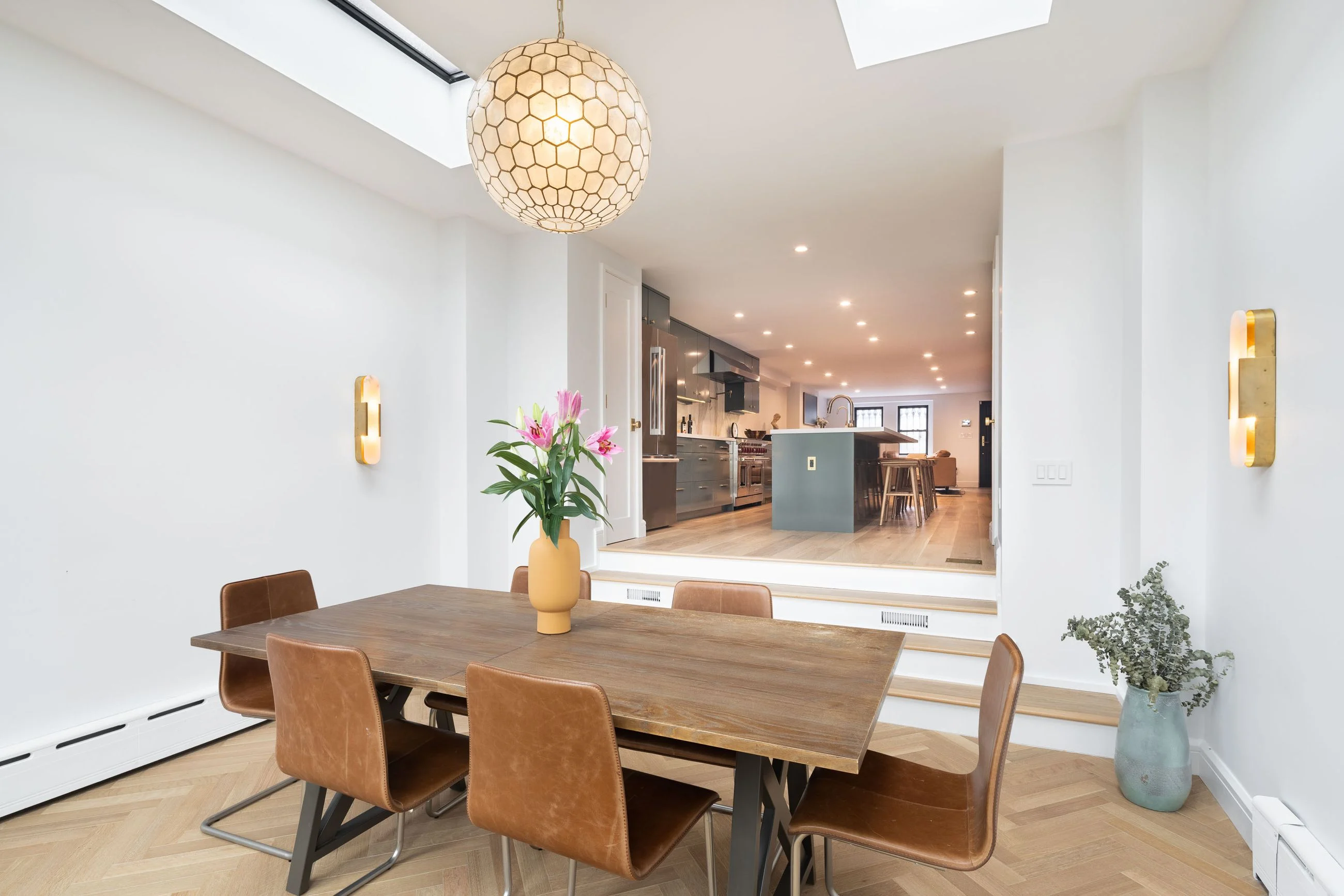The Essential Guide to Electrical Updates in NYC Apartment Renovations
Upgrading an apartment’s electrical system in NYC comes with unique challenges—here’s what to know before starting your renovation.
February 11, 2025
|
.jpg)
The Essential Guide to Electrical Updates in NYC Apartment Renovations
Electrical upgrades in NYC apartments can be complex—here’s what to consider.
Table of contents
- Benefits Of An Updated Electrical System in NYC Apartments
- Can Your Building Handle an Electrical Upgrade?
- Cost Considerations For Electrical System Upgrades
- Timeline Considerations For Electrical Upgrades In NYC Apartments
- Working With Professionals For A Smooth Electrical Upgrade
If you’re renovating an apartment in New York City—especially in an older pre-war building—upgrading the electrical system is a key consideration. Many apartments still rely on outdated wiring that can’t support modern appliances, smart home technology, or advanced HVAC systems. Moreso, many older NYC apartments have outdated wiring that does not meet current code, and hence, will not pass electrical inspections. Whether your renovation plans call for induction cooking, automated lighting, or high-performance AC, ensuring the electrical setup is capable of handling these impending upgrades is crucial.
Unfortunately, upgrading an apartment’s electrical system isn’t easy as flipping a switch. The feasibility and cost depend on several factors, including the building’s infrastructure, the location of your NYC unit, and the overall complexity of the renovation. The following article aims to unpack the challenges and benefits of upgrading the electrical system of your NYC apartment, while explaining why working with the right renovation partner is essential to successfully navigating this precarious project.

[#1]Benefits Of An Updated Electrical System in NYC Apartments[#1]
Older NYC apartments often have electrical service limited to 40–60 amps—far below what is needed for today’s high-powered appliances. If you are dealing with frequent tripped circuits, outdated wiring, limited outlets, or voltage issues, now is the time to consider an upgrade to your home’s electrical. A modern electrical system prevents overloading, enhances safety, and ensures your home can handle the increased power demands of modern living.
Contemporary Renovations Require More Power
Many high-end appliances and smart home features demand significantly more electricity than older systems can provide. For example, each of the following high-end home integrations requires an added electrical load capacity.
- Induction Stoves
- Steam Ovens
- Advanced HVAC Systems
- Heated Floors
- Smart Home Automation
- Advanced Integrated Lighting Systems
Most of these upgrades require at least 100 amps, and in many cases 200 amps—far more than many older buildings were designed to handle. Without a proper electrical system, these features may not function properly, or worse, could pose a safety risk.
Safety & Standard Compliance
Beyond modern appliances simply being cool, an upgraded electrical system improves the safety and energy efficiency in your apartment. The older wiring found in many of NYC’s various pre-war buildings can become a fire hazard over time, especially when pushed beyond capacity. By installing a 200-amp system, you reduce the risk of electrical issues and ensure compliance with contemporary safety standards.
Future-Proofing Your NYC Apartment
Upgrading your electrical system is one of the best ways to future-proof your NYC apartment. As technology advances—whether through energy-efficient appliances or expanding smart home systems—ensuring your apartment’s electrical system is up to date will keep your home prepped for technological opportunities, helping you avoid costly adjustments down the line.
Further Reading: Renovations & Technology: 10 Smart Home Remodeling Ideas
.jpg)
[#2]Can Your Building Handle an Electrical Upgrade?[#2]
As you can imagine, upgrading the electrical system in a NYC apartment can be complicated. However, the process becomes even trickier in specific pre-war buildings. Before assuming your electrical update will be straightforward, consider the following building-specific factors that could impact both the timeline and cost of your NYC renovation:
Existing Electrical Infrastructure
Many pre-war buildings in NYC have electrical systems designed for much lower power needs. Outdated wiring, smaller service panels, and older riser systems may not be able to support modern electrical loads. To ensure a successful upgrade, a thorough evaluation by an experienced electrician or electrical engineer is essential. This will help identify weaknesses in the current system and provide a clear path for necessary updates, ensuring your system can be updated to accommodate a modern lifestyle.
Space For New Wiring
In tightly designed spaces, such as penthouses or older buildings with narrow stairwells and shafts, running new electrical conduits can be challenging. The available space for routing new wiring can be limited, making installation difficult. To overcome this, a detailed assessment of the building’s layout is required. From there, creative solutions—like using existing pathways or utilizing less invasive installation methods—can help ensure the upgrade is feasible without compromising the building’s structure.
Building Riser Capacity & Penthouse Access Issues
In older buildings, the vertical conduits (or risers) that distribute electricity throughout the building may not be designed to handle the increased load of modern electrical systems. This can be a significant concern for penthouses, which are often located at the top of the building and may require extended wiring runs. The further an apartment is from the building’s main riser, the more challenging and costly it can be to upgrade the system. Expanding or upgrading the riser to accommodate higher electrical demands can involve extensive work and planning. In some cases, modifications to riser capacity are necessary, which can delay the renovation timeline and add considerable expense.
Further Reading: 6 Key Considerations When Planning A Penthouse Renovation In Manhattan
Building Regulations And Approvals
Co-op and condo boards often have strict guidelines on electrical work, meaning you’ll likely need additional permissions or compliance reviews before proceeding. The key to streamlined approvals and red tape removal is working with a full-service design-build firm who has experience in these diplomatic conversations and even rapport with certain building boards.

[#3]Cost Considerations For Electrical System Upgrades[#3]
Upgrading the electrical system in your NYC apartment is a key component of any full or gut renovation. However, the electrical lift can also warrant significant financial investment. With so many variables in play, cost depends on several key factors, and understanding these considerations upfront will help you plan your renovation budget effectively while avoiding unexpected expenses.
Distance From The Electrical Riser
The farther your penthouse is from the building’s electrical riser, the more expensive the installation. In older buildings, risers are often located on lower floors, requiring longer electrical runs to reach the top, which increases both material and labor costs.
Upgrading To A 200-Amp Service Panel
A 200-amp panel is essential for modern appliances, but upgrading requires both hardware and labor costs to integrate seamlessly into your building’s existing electrical system. A full-service design-build firm is ideal for this type of upgrade, as they can incorporate the electrical system improvements within the overall project timeline, ensuring everything is coordinated ad hoc and compliant with city code requirements.
Reconfiguring Wiring And Circuits
To handle the increased electrical load, you may need to rewire your apartment or reconfigure circuits, particularly for high-demand appliances like induction stoves and luxury HVAC systems. This adds both material and labor costs to the project.
For more details on cost of rewiring your apartment, read our blog Whole Home Rewiring In NYC: Costs & Tips To Consider.
Installation Complexity
In certain instances, installation methods can add complexity and cost. Navigating tight spaces, using exterior scaffolding, or other specialized techniques may be required, depending on your building’s design. These required add-ons increase labor costs and may require special permits.

[#4]Timeline Considerations For Electrical Upgrades In NYC Apartments[#4]
Upgrading the electrical system in your NYC apartment requires careful planning and precision in execution. With so many components to consider - including installing a new service panel, rerouting circuits, and ensuring compliance with building codes - means electrical upgrades don’t exactly move at the speed of light. Depending on the size of the renovation and the specific conditions of the building, this work can take several weeks or even months. Knowing what factors affect the timeline is key to managing expectations and coordinating other parts of your renovation.
Permits & Approvals
NYC’s strict building codes and permit requirements are one of the main factors that can slow down the electrical upgrade process. Securing the necessary approvals from the Department of Buildings and any co-op or condo boards can add significant time to the timeline, especially in historic buildings where additional reviews may be needed.
Building Access And Infrastructure
In high-rise buildings or older structures, logistical challenges such as tight spaces, narrow shafts, and existing electrical limitations can make the process more time-consuming. Running new wiring or upgrading infrastructure in these environments often requires careful planning and may necessitate using specialized equipment or methods, which can extend the timeline.
Coordination With Other Renovation Phases
When electrical updates are required amidst a full or gut renovation, coordinating them with other construction phases becomes crucial. Electrical work must align with the overarching renovation timeline to prevent delays. For example, tasks like reconfiguring circuits or installing new panels often need to be completed before drywall or finishes can be installed.
-min.jpg)
[#5]Working With Professionals For A Smooth Electrical Upgrade[#5]
As you can see, updating your NYC apartment’s electrical system is not a light load. Given the challenges and cost variables involved, working with a skilled design-build firm experienced in navigating NYC’s complex building codes and electrical systems is often the best approach. A full-service contractor like Gallery can help guide the entire process—from initial feasibility studies to managing permits and approvals—while also ensuring the work aligns with your overall renovation vision.
Considering an apartment renovation in New York City that includes an electrical system update? View our portfolio of NYC apartment renovation before and afters, learn more about Gallery, or contact us today. We are an award-winning design-build firm in New York City with a full-service approach to renovations in Manhattan and Brooklyn that includes everything from interior design and architecture services to board approvals and construction management. We’re experts in pre-war apartment renovations, apartment combinations, room creations, full gut renovations and all that falls in between. Let us bring your dream home to life.

.png)
.png)





.jpg)

%20(2).jpg)


.jpg)
%20Gallery%20KBNY.JPG)


